We saw that email and immediately reached out to the contact and set up a virtual evaluation.
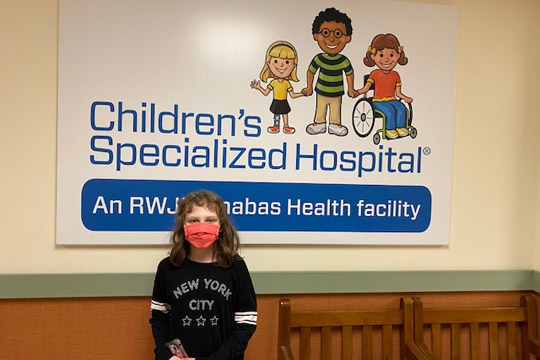
Emily Steel was born on March 16, 2011, as the only child to Melanie Steel and her husband, Matt. Melanie and Matt noticed Emily was developing later than her peers with most things, including walking and potty training, and at the age of three, her daycare teacher pointed out that Emily wasn’t speaking as well as other kids in the class and recommended that Melanie explore Early Intervention Services. That’s when Emily was introduced to speech therapy, occupational therapy, and physical therapy.
“After about a year or two of early intervention services, Emily was in kindergarten and the school said she could continue with speech, but there was nothing more they could do,” shares Melanie. “She was going to be mainstreamed with the other kids, we didn’t have any kind of diagnosis yet, and Emily was still having trouble with her gross motor skills and had developed clicking in her hips and pigeon toes.”
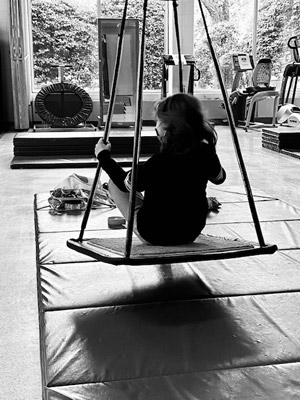 “Speech was our main concern…we couldn’t understand her,” Melanie continues. “She was also always very wired and never slept. She bounced off the walls. There were other signs too, like not making eye contact and not playing with her peers. She always seemed to be in her own little world.”
“Speech was our main concern…we couldn’t understand her,” Melanie continues. “She was also always very wired and never slept. She bounced off the walls. There were other signs too, like not making eye contact and not playing with her peers. She always seemed to be in her own little world.”
By age six, Emily’s energy got to be too much in school; she was all over the place or completely inattentive and teachers couldn’t reach her. “Her teachers loved her, but she was just really hyper and couldn’t sit still. I was feeling very alone and we still didn’t have answers from our pediatrician,” shares Melanie. “One day, Emily’s grandma came to an appointment with us and said to the doctor, something is going on here. That’s when he diagnosed her with combined type ADHD (Attention Deficit Hyperactivity Disorder). We were sent to another doctor who prescribed Emily medication, and sent us on our way.”
FINDING A DIAGNOSIS
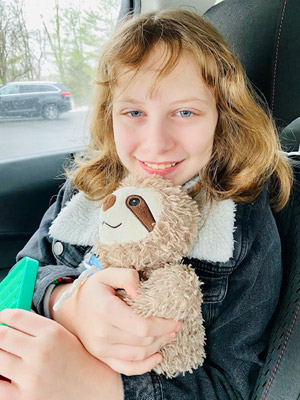 At that point, Melanie started looking into other options and opinions. When she took Emily to a nearby hospital for an evaluation for ADHD, the doctor that was treating Emily asked if she had ever been evaluated for autism, and recommended that Melanie look into Children’s Specialized Hospital (CSH).
At that point, Melanie started looking into other options and opinions. When she took Emily to a nearby hospital for an evaluation for ADHD, the doctor that was treating Emily asked if she had ever been evaluated for autism, and recommended that Melanie look into Children’s Specialized Hospital (CSH).
Emily came to CSH where she was evaluated and diagnosed with Autism Spectrum Disorder (ASD). “She’s on the spectrum and also has development coordination disorder and sensory processing disorder,” shares Melanie.
Shortly after the diagnosis, things went on hold. Melanie’s father-in-law, whom they lived with, passed away. “We have lived with my in-laws from the time Emily was about a year old,” shares Melanie. “When my father-in-law passed, Emily really went through a rough patch. That was her best friend and she spent so much time with him at home.”
After the passing of her grandfather, the COVID-19 pandemic hit, and at the age of almost ten, Emily still needed a lot of help dressing herself, and was unable tie her shoes or brush her hair on her own. That’s when Melanie says she started following CSH on social media and received an email during quarantine about virtual occupational therapy evaluations that were being offered to families. “We saw that email and immediately reached out to the contact and set up a virtual evaluation.”
MASTERING SKILLS
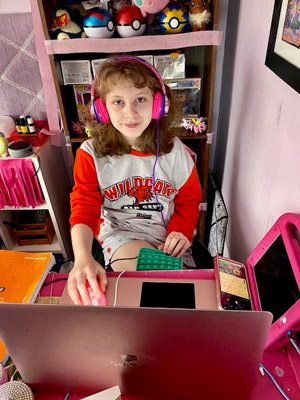 After the evaluation, it was recommended that Emily come for occupational therapy (OT) for 16 weeks in Mountainside, working with occupational therapist Karen Cherian. “Karen is a godsend,” shares Melanie. “Within a couple of weeks, she had Emily tying her shoes, brushing her hair and getting dressed on her own. Emily took to her right away and loves her. Karen has gotten her to open up and share things. She relates to Emily and talks to her like she’s an adult. She’s just a rock star!”
After the evaluation, it was recommended that Emily come for occupational therapy (OT) for 16 weeks in Mountainside, working with occupational therapist Karen Cherian. “Karen is a godsend,” shares Melanie. “Within a couple of weeks, she had Emily tying her shoes, brushing her hair and getting dressed on her own. Emily took to her right away and loves her. Karen has gotten her to open up and share things. She relates to Emily and talks to her like she’s an adult. She’s just a rock star!”
“When I first met Emily, she was a sweet shy girl who was a little apprehensive about starting OT,” shares Karen. “I made sure that our sessions were fun and involved things she liked to do. As we continued to build our relationship she began to open up and we started to talk about the things she had trouble with. I worked with Emily and her mom to break down these tasks into smaller achievable components so that she can be successful and build up her confidence.”
Throughout her therapy sessions, Emily has continued to work on hitting milestones, including tying her shoes and riding her bike, “we all tried teaching her, and it wasn’t taking,” said Melanie. “All her friends were able to do those things and she couldn’t. Karen showed her a couple of steps each session to build on the skills each week.”
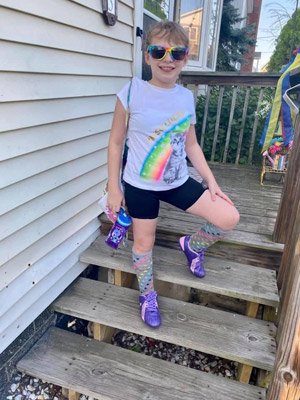 “The greatest moments of our time together were helping Emily learn how to ride a bike,” continues Karen. “Each session she achieved a little bit more and most importantly she was building her confidence and didn’t give up. Even when she would fall she would get back on and kept trying which is something she wouldn’t have done in the beginning.”
“The greatest moments of our time together were helping Emily learn how to ride a bike,” continues Karen. “Each session she achieved a little bit more and most importantly she was building her confidence and didn’t give up. Even when she would fall she would get back on and kept trying which is something she wouldn’t have done in the beginning.”
“When Emily was finally able to ride her bike around the gym for more than 10 seconds, she ran up to me and was just so happy! Of course, I was crying and Karen was cheering, and it was just such an incredible moment,” shares Melanie. “But Emily is very competitive with herself and I tell her, not every week is going to be perfect. There are weeks you may feel defeated. Keep moving forward!”
Overall, Melanie shares that occupational therapy has been an incredible tool for Emily, especially with learning lifestyle skills that aren’t covered in school. “If I have a concern or notice something that Emily needs help with mastering, I bring it up to Karen and she’s on it,” she shares. “Not that you want anything to be wrong with your kids, but to finally have a diagnosis after noticing that something was different has been so freeing. I want her to be able to do these things on her own and I can see that she feels better! I can see the change in her as she’s learning things like tying her shoes.”
AN OLD SOUL
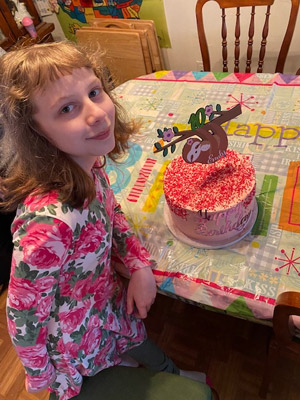 Emily is doing well in school and has achieved honor roll, but still struggles socially and with her gross motor skills. She’s great at math and loves history but struggles with reading. “She loves Amelia Earhart,” shares Melanie, “she learned about her in school and is fascinated.” Emily also enjoys video games, especially “Roblox” and “The Sims”, where she can make characters and create them after characters from her favorite movies.
Emily is doing well in school and has achieved honor roll, but still struggles socially and with her gross motor skills. She’s great at math and loves history but struggles with reading. “She loves Amelia Earhart,” shares Melanie, “she learned about her in school and is fascinated.” Emily also enjoys video games, especially “Roblox” and “The Sims”, where she can make characters and create them after characters from her favorite movies.
She also enjoys playing soccer and is a member of the Girl Scouts. “It’s funny, she’s been in Girl Scouts since she was a Daisy,” says Melanie, “but during the meetings you will find her hanging out with the moms and other adults. She’s great with adults but gets anxiety and uncomfortable around her peers. She’s like an old soul.”
Melanie continues on to share that Emily does still have friends from her Pre-K class that love her, and is best friends with her cousin. “She loves talking to her friends on FaceTime and seems more comfortable talking to them that way, or while they’re gaming. She’s lucky she has people who ‘get’ her.”
LOOKING FORWARD
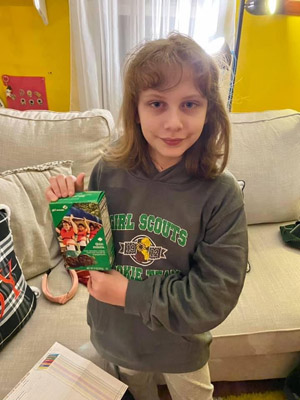 Melanie shares that she is beyond thrilled with the progress Emily is making with occupational therapy, especially after many years of feeling alone. “My advice to anyone going through a similar journey is to remind yourself that you’re not crazy and you’re not alone,” she says. “Even if you have to keep fighting with your child’s school to find outside services, or keep advocating with your doctors for a second opinion, trust your gut. Deep down I knew there was something our initial pediatrician and the school system was missing. No one knows their kid better than we do as parents and if we don’t advocate for them, who will?”
Melanie shares that she is beyond thrilled with the progress Emily is making with occupational therapy, especially after many years of feeling alone. “My advice to anyone going through a similar journey is to remind yourself that you’re not crazy and you’re not alone,” she says. “Even if you have to keep fighting with your child’s school to find outside services, or keep advocating with your doctors for a second opinion, trust your gut. Deep down I knew there was something our initial pediatrician and the school system was missing. No one knows their kid better than we do as parents and if we don’t advocate for them, who will?”
“Nobody’s perfect and nobody knows everything, so keep fighting for answers,” shares Melanie. “Also finding community helps. A lot of my friends have kids younger than Emily and they’re not going through these same obstacles. When I post to my social media platforms, I post the good and the bad so others can see that it’s not always easy and they’re not alone.”
When it comes to Emily and her future, Melanie shares that her biggest hope is that Emily feels good about herself and has the perspective that things may be hard at times, but she can do whatever she sets her mind to.
“I want her to know that things aren’t going to be handed to her and she has to work for them,” shares Melanie. “I tell her that she may have to work harder than others to achieve certain things, but other people may be struggling with something else that comes naturally to Emily. I want her to know that as long as she keeps working on it, she can do it.”